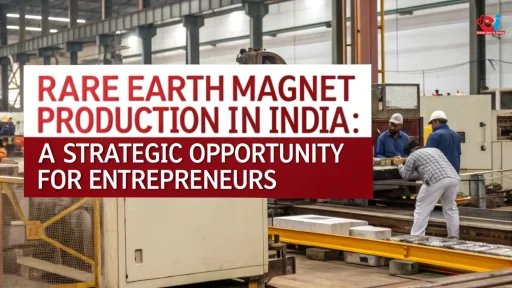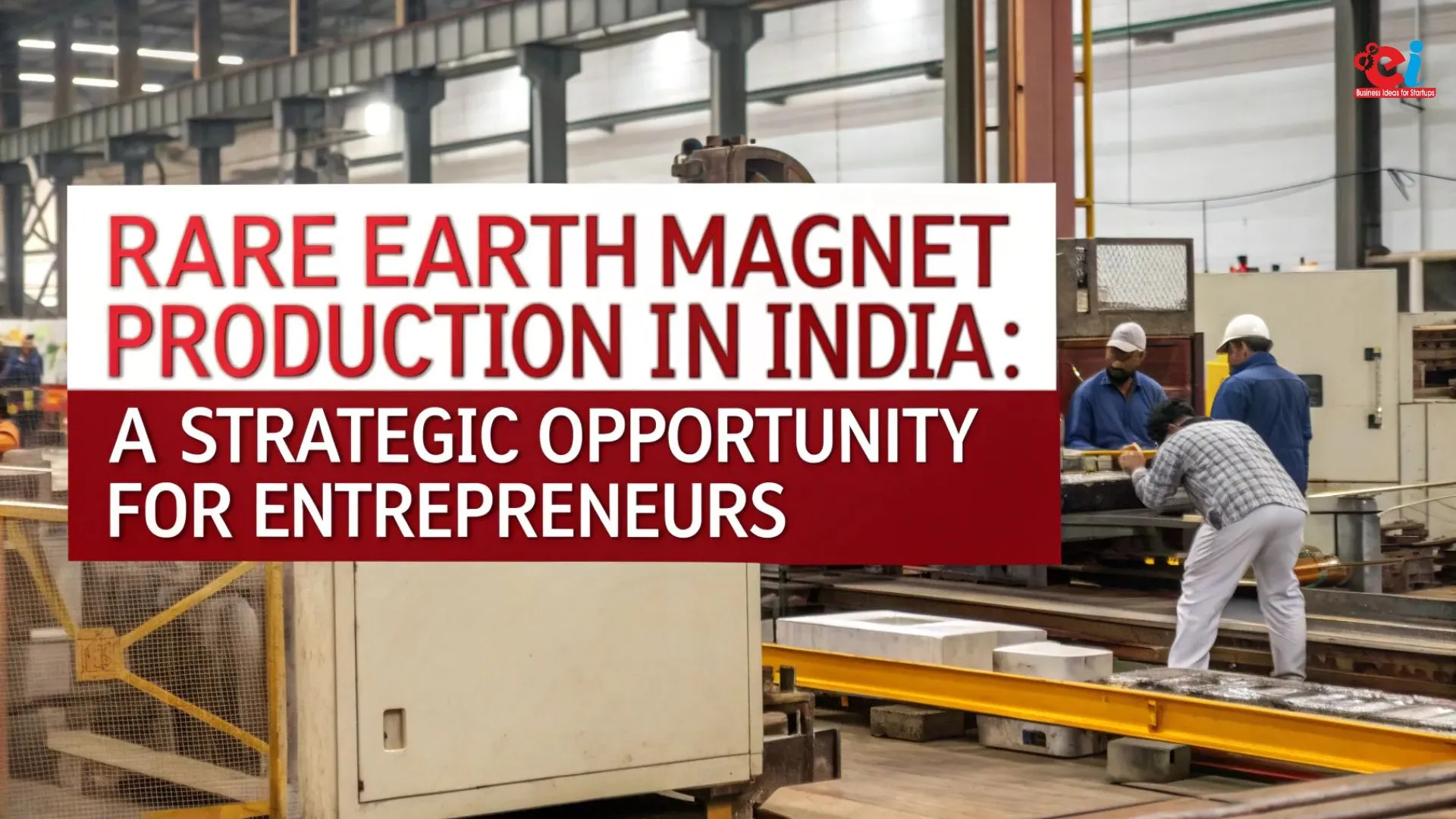Powering India’s Future with Rare Earth Magnets
Consider the potential to power electric vehicles, wind turbines, and other advanced electronics in India. This is the transformative potential of rare earth magnets, and they are now actively looking for entrepreneurs to establish this vision. The Government of India, through Union Minister G. Kishan Reddy, has been advocating for private investment in rare earth magnet manufacture opening an important high-growth sector.
For discerning entrepreneurs and startups eager to enter advanced manufacturing, this is more than a business opportunity; it is an opportunity to contribute to India’s self-reliance in a key technology. India currently imports nearly all its rare earth magnets, especially from China, which creates immense supply chain vulnerabilities.
1. Why Rare Earth Magnets? Knowing the Important Part
Rare earth magnets, especially Neodymium-Iron-Boron (NdFeB) magnets, are the strongest permanent magnets known. Some of the modern technology uses include:
- Electric Vehicles (EVs): Essential for electric motors (traction motors) and ancillary systems.
- Wind Turbines: Used in direct-drive and geared generators.
- Consumer Electronics: In smartphones, including vibrators and speakers, hard disk drives, headphones, and micro motors.
- Industrial Automation & Robotics: Control precision motors, actuators, and sensors.
- Defence & Aerospace: Guidance systems, actuators, radar, and satellites.
These directly relate to India’s increasing goals in adopting EV technologies (with a target of 30% penetration by 2030) and non-fossil fuel accelerated RE (Renewable Energy) 500 GW of capacity by 2030. India would need these powerful magnets in much greater quantities.
Related: Rare Earth Metals for Industrial Startups
2. The Government Push: Fueling Domestic Production
The announcement made by Minister Reddy marks the arrival of a new policy framework. Among other stated objectives, some key government initiatives are positively affecting productivity for entrepreneurs and include:
- PLI Schemes: While we are still awaiting details of a specific PLI for magnets, the Advanced Chemistry Cell (ACC) Battery Storage PLI and the Auto & Auto Components PLI are boosting demand somewhat, and so is the pending magnet PLI.
- Critical Minerals Strategy: The Government is internationally sourcing supplies of rare earth elements (REE), as well as looking to develop local sources. KABIL (Khanij Bidesh India Ltd.) is one example of companies attempting to acquire overseas mineral assets.
- Reduced Reliance on Imports: Breaking China’s grip on magnet production (over 90% of global supply) is vital to national security and economic resilience.
- Ease of Business & Infrastructure Improvements: Continued development of power and logistics infrastructure, including industrial corridors, is beneficial to high-tech manufacturing.
This means for businesses:
- Tailwind Policy: Encouragement from the government is a sector where the business operates.
- Assured Market: National goals are driving up domestic demand.
- Possible Benefits: Government financing, taxes, and subsidies might be offered.
3. Market Prognosis: Catching the Growth Wave
According to numerous market research studies, the global rare earth magnet market is booming and is projected to reach $38.6 billion by 2030 at a compound annual growth rate of 8.5%. With India’s significant growth potential, we can do even better:
- EV Revolution: An electric vehicle contains 1-3 kg of NdFeB magnets. Even with conservative estimates, India’s electric vehicle magnet demand could reach 10,000–15,000 tons per year by 2030.
- Expansion of Wind Energy: Adding significant GW capacity equates to thousands of new wind turbines. Each turbine requires hundreds of kilograms to tonnes worth of magnets.
- Hub for Electronics Manufacturing: Mobile smartphones and domestic appliances as India’s focus in the electronics sector stems from emerging downstream markets.
- Growth in Industrial Production: The Adoption of automation and robotics in different industries increases overall demand.
Key Demand Drivers in India:
- EV and renewables adoption along with government policies and subsidies.
- Increased penetration of consumer electronics.
- Modernization of military infrastructure.
- Advancing level of sophistication in manufacturing processes.
India’s domestic magnet production capacity is non-existent. This gap represents the core opportunity for new entrants.
Related: Rare Earth Alloys for Industrial Startups
4. Rare Earth Magnet Manufacturing Process
Sourcing rare earth oxides such as neodymium, praseodymium and others will likely be imported as concentrates or oxides. Here’s a rough sketch:
a) REOs Raw Material Sourcing and Processing
Separation and purification via complex solvent extraction enables the capture of REO separation plants, giving rise to parallel and high-value opportunities. Processing involves separation and purification.
b) Alloy Production
- Electrolysis utilizing molten salts can change newly purified Rare Earth Oxides to metals.
- An induction furnace allows for precise alloying of metals with Iron and Boron. Dysprosium can also be added for high-temperature performance to make NdFeB alloy ingots.
c) Powder Processing (Crucial Step)
- Jet Milling: In nitrogen or argon gas, which acts as an inert atmosphere, ingots are oxidized and milled into fine powders. Particle distributions need to be the right size for optimal magnetic performance.
d) Pressing
- A die holds the powder that was received from jet milling.
- Alignment: A powerful magnetic field magnetically aligns the powder particles to polarize them.
- Pressing: The powder is compacted using isostatic pressing.
e) Sintering
- The so-called “green” blocks are compacted and then sintered under a vacuum at 1000–1100°C. High temperatures enable the bonds between powders to fuse, which is needed for the microstructure.
f) Annealing
- This step optimizes the microstructure developed in the previous steps while maintaining important magnetism.
g) Machining & Coating
- Brittle sintered blocks can also be shaped and refined into desired precision shapes through diamond tool grinding, cutting, and slicing.
- Coating: Corrosion-resistant coverings like Nickel, Zinc, and Epoxy can be coated to add a layer of protection.
h) Magnetizing
- The magnetizer exposes the finished magnet to an extremely powerful pulsed magnetic field, which aligns its internal domains and activates its full magnetic strength.
i) Quality Control & Testing
- Testing for Br, Hc, BHmax, dimensions, coating integrity, and corrosion resistance all require great scrutiny.
Key Considerations for Entrepreneurs
- Scale: Significantly more capital is needed to achieve economies of scale.
- Technology: Specialized tools and knowledge are critical for the processes involved.
- Environment: Vacuum sieving of fine powders and chemical usage require stringent safety and environmental protocols.
- Quality: There must be consistent, high-quality output for all N35, N42, N52 grade magnets. Meeting international standards is non-negotiable.
5. Opportunities for Entrepreneurs: Where to Focus
Instead of starting with a fully integrated mine-to-magnet operation, these are some entry points to consider:
- Magnet Manufacturing: Focus on specific shape or grade sinters.
- Magnet Recycling: Recovery of rare earths from end-of-life products such as e-waste, electric vehicle motors, and hard disk drives is becoming cheaper and more important.
- Specialized Machining & Coating: Providing precision machining and coating to magnet producers.
- Rare Earth Separation & Purification: Processing imported concentrates into high-purity oxides/metals.
6. Challenges and Mitigation Strategies
Navigating the hurdles requires awareness.
- High Capital Investment (CAPEX):
Construction of a plant requires significant investment in land, sintering furnaces, jet mills, magnetizers, and clean room facilities.
Mitigation: Government subsidies/ PLI benefits. Joint ventures. Phased investment beginning with recycling or machining. - Raw Material Supply and Pricing Volatility:
REOs imported pose a risk for supply volatility, causing imported businesses to be at risk for supply streams and price fluctuations.
Mitigation: Long term supply contracts. Diversified sourcing. Government partnerships via KABIL. Exploring raw material recycling streams. Advocacy for raw material procurement policy. - ERG Metals requires deep expertise in metallurgical and process engineering, along with complex technology and a skilled workforce.
Mitigation: Form partnerships with IITs and CSIR. Hire foreign experienced personnel on a temporary basis. Provide extensive training and hire domestic talent. Collaborate with technology licensors. - Staying relevant and unique in a market with established, low-cost producers from China.
Mitigation: Domestic OEMs targeting reliable supply chains and are willing to pay for quality, coverable, and dependable high-performance grades. Focus on “Made in India” branding, Recycling innovations, and niche application developments. - Stringent regulations on the handling of chemicals, emissions, and waste disposal.
Mitigation: overarching:: Environmental pollution controls: Integrating best practices on environmental pollution controls within plant designs from the first day. Investing in advanced pollution controls.
7. The Path Forward: Launching Your Venture
As with everything, taking the plunge requires meticulous planning:
- Deep market research:
Validate product-market fit (e.g., magnets for EV two-wheelers vs. industrial motors). Assess competitors. - Feasibility Study:
This is non negotiable. A thorough study will put a mark on a lot of fields like technical viability, how much money will be spent, if it can earn revenue, and if it’s risky.
How Niir Project Consultancy Services (NPCS) Can Help:
NPCS is a trusted name for entrepreneurs venturing into new industrial domains. They prepare comprehensive Market Survey cum Detailed Techno Economic Feasibility Reports tailored for projects like rare earth magnet manufacturing. These reports are invaluable as they describe in-depth the manufacturing process and raw materials sourcing and costing, plant and machinery detail, manpower planning, and financial projections like CAPEX, OPEX, profitability, ROI, and break-even analysis. With NPCS’s help, entrepreneurs are able to rigorously test the feasibility of setting up a rare earth magnet plant and reduce risks while strengthening the business plan to attract investors and lenders.
Get funding:
Craft a good business plan and approach venture capitalists, private equity, government funding agencies (SIDBI, IREDA), and banks. Emphasize strategic importance.
Placement and Framework:
Select an industrial zone that has reliable electricity, water, transportation, and is near to potential clients like auto hubs and industrial belts.
Build Partnerships:
Start to form deals with prospective customers (OEMs), raw material vendors, and R&D collaborators early.
Focus on Quality & Certification:
From the beginning, work towards meeting international standards such as ISO and IATF 16949 for automotive.
For more information watch the video on this article
Conclusion: Containing the Opportunity in a Magnetizing Market
Rare earth magnets production in India has a lot of potential. Fantastic government policies, soaring domestic need driven by electric vehicles, renewables, and a growing need to secure supply chains all provide sheer opportunity. While there are issues around capital, technology, and raw materials, strategically planning and leveraging available support can help overcome them.
This isn’t simply to build a profitable business for the visionary entrepreneur, but rather, taking part in constructing India’s clean energy future and technological sovereignty expansions.
By undertaking comprehensive due diligence, acquiring the appropriate expertise Rodentovskii claimed that some resources on here that hieroglyphs also can prove helpful and partnerships,osos by perhaps us districts or in NCPC service for feasibility assesments, one can set their innovation or plants ‘venture’ to be at n the leading edge of this strategically crucial and expanding industrial sector. Your remittance letter now awaits, and this will redefine ‘Make in India’.







